Honey is a versatile ingredient with various uses and benefits. It is a sweet fluid made by honeybees using the nectar of flowering plants. There are about 320 different varieties of honey, each varying in color, odor, and flavor. Honey contains mostly sugar, as well as amino acids, vitamins, minerals, iron, zinc, and antioxidants. It can be used as a natural sweetener and has anti-inflammatory, antioxidant, and antibacterial properties. Research suggests that honey may have various health benefits, such as reducing the risk of cardiovascular disease, acting as a cough suppressant, relieving gastrointestinal conditions, offering neurological benefits, and promoting wound healing.
Key Takeaways:
- Honey is a versatile ingredient with multiple uses and benefits.
- It contains sugar, amino acids, vitamins, minerals, iron, zinc, and antioxidants.
- Research suggests that honey has anti-inflammatory, antioxidant, and antibacterial properties.
- Honey may reduce the risk of cardiovascular disease, act as a cough suppressant, relieve gastrointestinal conditions, offer neurological benefits, and promote wound healing.
- It can be used as a natural sweetener and in various culinary applications.
The History and Origin of Honey
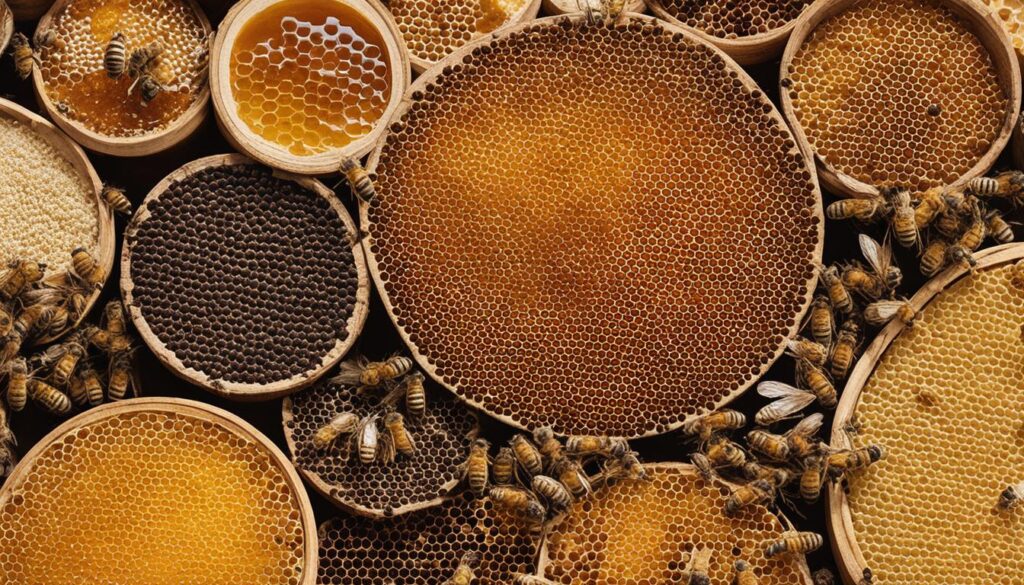
Honey has a long and storied history, with its origins dating back thousands of years. This golden, sweet substance has been cherished by civilizations throughout time for its unique taste and medicinal properties. The history of honey is intertwined with the practice of beekeeping and the fascinating journey of honeybees in collecting nectar from flowering plants.
In ancient records, the significance of honey can be found in texts such as the Quran and Egyptian scriptures, highlighting its value and importance. Since ancient times, humans have recognized the incredible benefits of honey, both as a food source and as a natural remedy for various ailments.
The journey of honey begins with honeybees diligently seeking out the nectar of flowers. These diligent insects collect the nectar and carry it back to their hives. Through the process of regurgitation and enzymatic activity, the nectar is transformed into delicious honey.
The sweetness and medicinal properties of honey have been cherished by cultures around the world for centuries. Honey has been used as a sweetener, a preservative, and a healing agent. Its properties have even led to its inclusion in folk remedies for various ailments.
The history and origin of honey reveal the intrinsic connection between humans, honeybees, and the natural world. The appreciation and utilization of honey have withstood the test of time, making it an enduring part of our cultural and culinary heritage.
The Evolution of Beekeeping
Throughout history, humans have developed various methods of beekeeping to cultivate honey and benefit from its abundant rewards. The art of beekeeping has evolved, with different techniques and structures used across different cultures and time periods.
In ancient times, beekeepers built hives from natural materials such as hollowed logs or woven baskets. These early methods allowed beekeepers to manage and harvest honey while ensuring the survival of honeybee colonies.
As civilizations advanced, beekeeping techniques became more sophisticated. Egyptians and Greeks developed more complex hive structures, such as the iconic Egyptian clay pot hives. These advancements in beekeeping practices allowed for better honey production and collection.
Honey’s Importance and Significance
The history and origin of honey illuminate its enduring significance throughout human history. This natural sweetener has been treasured for its delicious taste, as well as its potential health benefits.
From ancient times to the present day, honey continues to captivate our taste buds and offer a myriad of uses. Whether consumed as a natural sweetener, integrated into culinary creations, or utilized in traditional medicine, honey holds a special place in our lives.
As we explore the world of honey and its fascinating history, we gain a deeper appreciation for the remarkable journey of honeybees and the remarkable substance they produce. Join me as we delve further into the properties and key components of honey, understanding its versatility and the myriad of benefits it offers.
Properties and Key Components of Honey
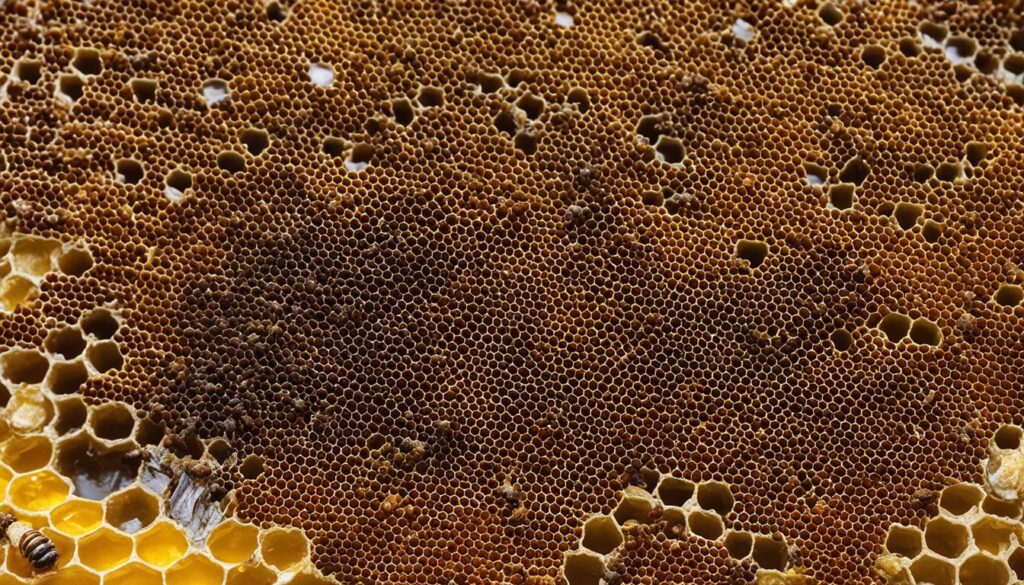
Honey is not just a sweet treat; it also possesses several unique properties and contains a variety of key components that contribute to its overall health benefits.
One of the primary components of honey is sugar. While it may primarily consist of sugars, honey also contains small amounts of essential vitamins and minerals, including vitamin C, calcium, and iron.
However, what sets honey apart is its rich content of health-promoting plant compounds called polyphenols. These polyphenols act as powerful antioxidants in the body, helping to neutralize harmful reactive oxygen species (ROS). ROS are known to contribute to conditions like premature aging, diabetes, and heart disease.
The specific properties and components of honey can vary depending on the variety and quality of the honey. Different flowers and plants produce unique types of honey, resulting in variations in color, flavor, and aroma.
The Antioxidant Power of Honey
Honey’s antioxidant properties are attributed to its polyphenol content. These antioxidants help protect the body’s cells from damage caused by oxidative stress. By neutralizing ROS and reducing inflammation, honey’s antioxidants contribute to overall health and well-being. The diverse range of polyphenols found in honey may also have additional health benefits beyond antioxidant activity.
“The diverse range of polyphenols found in honey may have additional health benefits beyond antioxidant activity.”
Research suggests that the antioxidants in honey may have potential anticancer, anti-inflammatory, and antimicrobial effects. However, further studies are needed to fully understand the specific mechanisms behind these potential benefits.
The Key Components of Honey
Here are some of the key components found in honey:
| Component | Description |
|---|---|
| Fructose | A natural sugar found in honey, contributing to its sweetness. |
| Glucose | Another natural sugar present in honey, providing energy. |
| Enzymes | Honey contains various enzymes that can aid in digestion and overall health. |
| Amino Acids | The building blocks of proteins, amino acids are essential for many bodily functions. |
| Minerals | Honey contains trace amounts of essential minerals like calcium, magnesium, and potassium. |
| Vitamins | While present in small amounts, honey contains vitamins such as vitamin C and B vitamins. |
These components work together to provide not only sweetness but also potential health benefits when honey is consumed as part of a balanced diet.
Culinary Uses of Honey
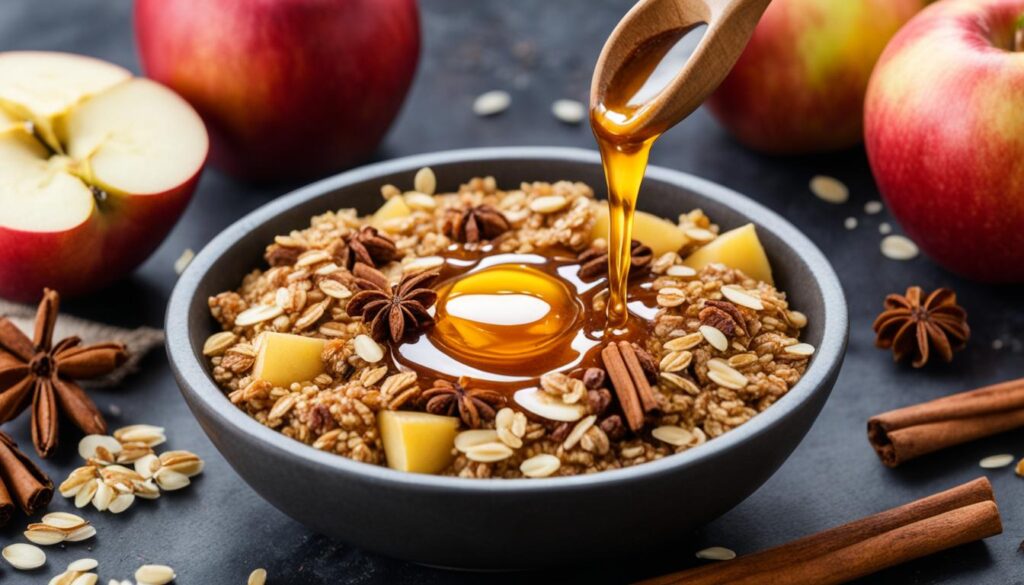
Honey, with its natural sweetness and unique flavor profile, is a versatile ingredient that can elevate both sweet and savory dishes. From drizzling it over yogurt to incorporating it into baked goods, honey adds depth and complexity to culinary creations. Let’s explore the various ways you can incorporate honey into your cooking.
If you have a sweet tooth, honey can be used as a healthy alternative to processed sugar in desserts and beverages. Its natural sweetness enhances the flavors of smoothies and can be used as a topping for pancakes or waffles. Honey can also be incorporated into baked goods like cakes, cookies, and bread, providing a moist texture and adding a subtle hint of sweetness.
Not just limited to sweet dishes, honey can also be used in savory recipes. Its complex flavor pairs well with cheeses, such as goat cheese or blue cheese, and can be a delightful addition to charcuterie boards. Honey can be used as a glaze for roasted meats, imparting a rich and caramelized flavor. It can also be used to create flavorful salad dressings, adding a touch of sweetness to balance out tangy or acidic ingredients.
Honey is renowned for its ability to enhance the natural flavors of fruits and nuts, making it a delightful addition to salads. It can be combined with balsamic vinegar, olive oil, and Dijon mustard to create a delicious honey mustard dressing. Adding a drizzle of honey to roasted vegetables brings out their natural sweetness and adds a delightful caramelized finish.
The culinary uses of honey are endless, limited only by your imagination. Experiment with different varieties of honey to explore their unique flavors. From the robustness of buckwheat honey to the light floral notes of orange blossom honey, each variety offers a distinct flavor profile that can elevate your dishes.
Honey’s natural sweetness and versatility make it a valuable ingredient in the kitchen, enhancing both sweet and savory dishes. From desserts to salad dressings, honey adds depth and complexity to culinary creations.
Culinary Uses of Honey
| Sweet Dishes | Savory Dishes |
|---|---|
|
|
Try incorporating honey into your cooking and unlock a world of flavors that will delight your taste buds. Whether you’re satisfying your sweet tooth or adding a touch of sweetness to savory dishes, honey is sure to bring a unique and delicious element to your culinary creations.
Personal Products and Health Remedies
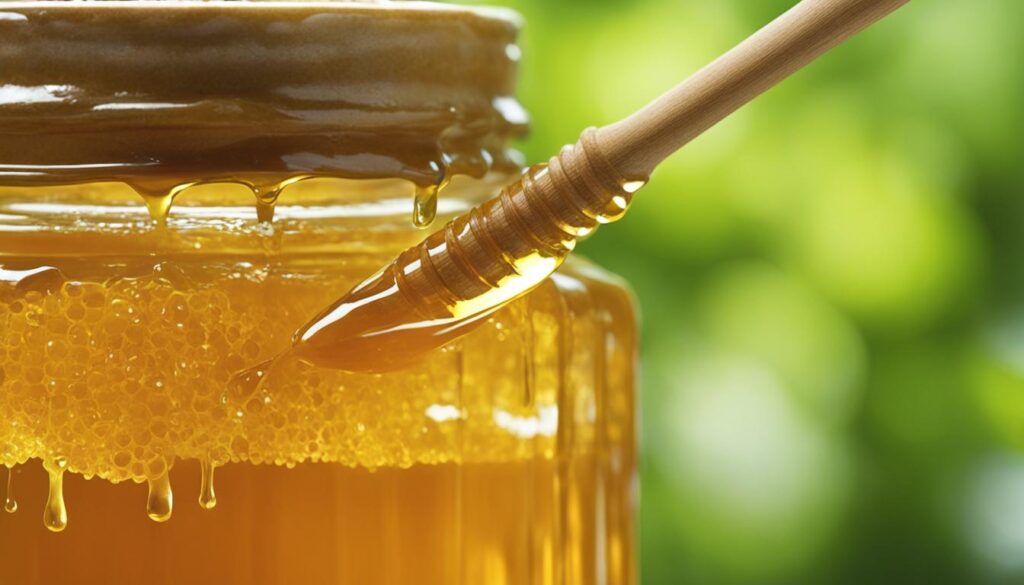
Honey is a versatile ingredient that finds extensive use in personal care products and health remedies. Its antibacterial and anti-inflammatory properties make it highly beneficial for skincare, while its nourishing properties promote healthy hair and scalp. Additionally, honey offers various natural remedies for common health concerns.
Honey for Skincare
Honey is renowned for its positive effects on the skin. It can be used as a natural facial mask, moisturizer, or as an ingredient in homemade skincare products. The antibacterial properties of honey help combat acne-causing bacteria and promote a clear complexion. Furthermore, honey’s anti-inflammatory properties help soothe and calm irritated skin.
When applied topically, honey acts as a humectant, attracting and retaining moisture in the skin. This makes it an excellent choice for individuals with dry or dehydrated skin. Honey also contains antioxidants that protect the skin from free radicals, reducing the signs of aging and promoting a healthy, youthful appearance.
Honey for Hair and Scalp
Honey is a potent ingredient for maintaining healthy hair and scalp. Its moisturizing properties help hydrate and rejuvenate dry and damaged hair. Honey can be used as a conditioning treatment, restoring moisture and promoting smoothness and shine.
Additionally, honey’s natural antibacterial properties help soothe scalp conditions such as dandruff and itchiness. It can be combined with other ingredients like coconut oil or aloe vera to create nourishing hair masks or scalp treatments.
Honey Remedies for Health
In addition to its benefits for the skin and hair, honey is widely used in natural remedies for various health concerns. It can be consumed orally or applied topically for its therapeutic effects.
Honey has been traditionally used to relieve coughs and sore throats. Its soothing properties help alleviate irritation and suppress coughing symptoms. Honey is particularly effective when combined with ingredients like lemon or ginger.
Furthermore, honey is believed to have allergy-relieving properties. Local, raw honey, when consumed regularly, may help reduce seasonal allergy symptoms by exposing the body to small amounts of pollen and building immunity over time.
Honey is also used as a natural aid in weight loss due to its unique composition of sugars. It is believed to provide a more sustained energy release compared to processed sugars and can be used as a healthier alternative to sweeten beverages and food.
Additionally, honey’s natural antimicrobial properties make it an effective agent in wound healing. It can be applied topically to minor cuts, burns, and scrapes to promote faster healing and reduce the risk of infection.
| Health Concern | Honey Remedy |
|---|---|
| Cough and Sore Throat | Honey with lemon or ginger |
| Allergies | Raw honey for seasonal allergies |
| Weight Loss | Honey as a natural sweetener |
| Wound Healing | Topical application of honey |
With its versatile applications in personal care and health remedies, honey proves to be a natural and effective ingredient. Whether incorporated into skincare routines, hair treatments, or used in various natural remedies, honey offers a range of benefits for overall well-being.
Household and Topical Uses

Honey, with its multitude of benefits, can be utilized in various ways within the household and for topical applications. Its natural properties make it ideal for soothing a persistent cough, aiding in weight loss, and promoting wound healing.
Honey for Cough Relief
If you’re dealing with a nagging cough, honey may provide much-needed relief. This natural remedy has been used for centuries to soothe coughs and alleviate throat irritation. When combined with ingredients like eucalyptus or citrus, honey can act as a powerful cough suppressant.
“Honey, combined with eucalyptus, has proven to be a valuable remedy in easing cough symptoms and calming irritated throats. Its soothing properties bring relief and help you get a good night’s sleep,” says Dr. Jane Roberts, a renowned holistic health practitioner.
Honey for Weight Loss
While there is no magic solution for weight loss, incorporating honey into a balanced diet could potentially support your weight management goals. Honey serves as a healthier alternative to processed sugars and can be used as a natural sweetener.
“Replacing processed sugars with honey in your diet can provide a more nutritious option. Its natural properties may help control cravings and promote satiety,” suggests nutritionist Samantha Lewis, RD.
Honey for Wound Healing
When it comes to minor sores and wounds, honey’s wound healing properties make it a reliable choice. Applying honey topically can promote healing, alleviate pain, and prevent infection.
“The antimicrobial and anti-inflammatory components of honey make it an excellent option for wound care. Its high sugar content creates a protective barrier while its antibacterial properties help prevent infection,” explains Dr. Michael Ramirez, a renowned dermatologist.
To harness the power of honey for wound healing, apply a thin layer of honey directly to the affected area, cover it with a sterile bandage, and change the dressing regularly.
Benefits and Applications
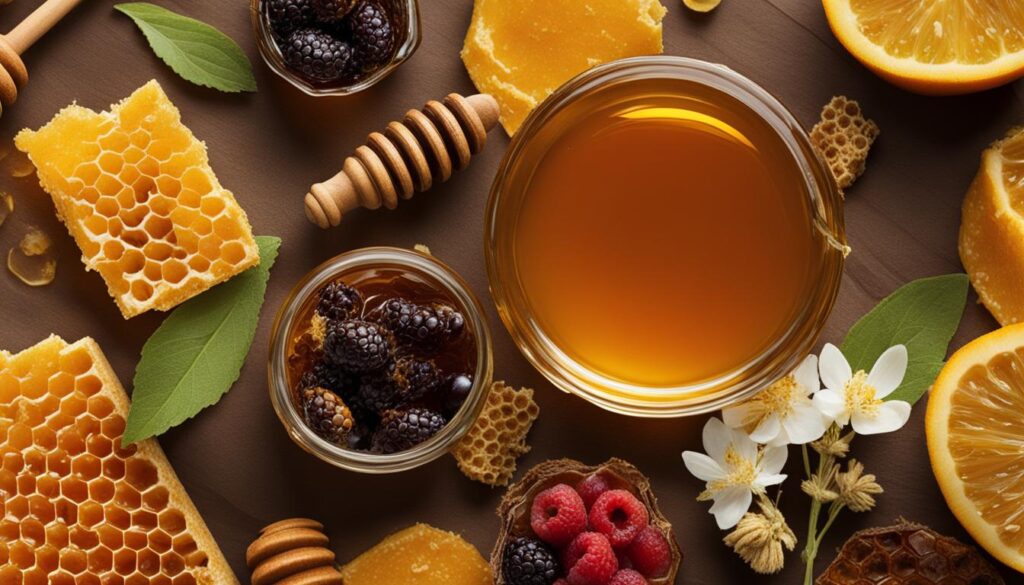
Honey offers a multitude of benefits that contribute to overall health and well-being. With its antioxidant properties, honey may help reduce the risk of heart disease and improve blood fat levels. Its natural components also suggest potential benefits in areas such as depression, epilepsy, anxiety, and memory enhancement.
“Honey’s antioxidant properties may reduce the risk of heart disease and improve blood fat levels.”
Furthermore, honey has shown remarkable effectiveness in promoting wound healing, especially in burn cases. Its antibacterial properties aid in preventing infections, while its anti-inflammatory effects reduce inflammation and support the healing process.
The applications of honey are extraordinarily diverse, making it a valuable addition to various aspects of life:
- Culinary Uses: Honey serves as a natural sweetener and flavor enhancer in a multitude of dishes. Its unique taste and versatility make it a popular ingredient in salad dressings, marinades, baked goods, and even beverages.
- Personal Care Products: Honey is widely used in skincare due to its antibacterial and anti-inflammatory properties. It can be found in facial masks, moisturizers, and haircare products, offering moisturizing, healing, and nourishing effects.
- Health Remedies: Honey has been used for centuries as a natural remedy for soothing coughs, relieving allergies, aiding in weight loss, and promoting wound healing. It is a key ingredient in various traditional and alternative medicine practices.
Combining the benefits and versatility of honey, it is undoubtedly a valuable and beneficial ingredient that can enhance multiple aspects of our lives.
Comparison of Different Types of Honey
| Type of Honey | Color | Taste | Floral Source | Health Benefits |
|---|---|---|---|---|
| Acacia Honey | Light, pale yellow | Delicate, floral | Acacia flowers | May aid in digestion, promotes skin health |
| Manuka Honey | Dark amber | Rich, earthy | Manuka tree | Antibacterial properties, supports wound healing |
| Wildflower Honey | Amber | Full-flavored, robust | Various wildflowers | Aids in allergy relief, boosts immune system |
Usage Tips and Cautions
When it comes to using honey, there are a few tips and cautions that you should be aware of. While honey is generally safe for most individuals, including adults and children over the age of 1, there are certain considerations to keep in mind.
- Avoid giving honey to infants: Honey should be avoided in infants younger than 1 year old. This is because honey has the potential to contain spores of the bacteria that causes infant botulism, a rare but serious illness.
- Be aware of allergies: Some individuals may be sensitive or allergic to specific components in honey, such as bee pollen. If you have known allergies or suspect a sensitivity, it’s essential to exercise caution when consuming honey and consult with a healthcare professional if necessary.
- Moderation is key: While honey offers various health benefits, it is still high in sugar and can affect blood sugar levels. Individuals with diabetes should monitor their honey consumption and incorporate it into their diet in moderation. It’s always a good idea to consult with a healthcare professional for personalized guidance.
- Watch out for adulteration: Unfortunately, honey adulteration is a concern in the market. Some producers dilute honey with plain syrup, compromising its quality. To ensure you’re getting pure honey, purchase from reputable sources and look for labels indicating purity or rawness. Independent testing or certification can also provide additional assurance.
By following these usage tips and cautions, you can enjoy the benefits of honey while making informed choices that prioritize your health and well-being.
Selecting the Best Quality Honey
When it comes to honey, selecting the best quality is essential to ensure its purity and authenticity. With so many varieties available, it can be confusing to determine which honey is the best. Follow these tips to make an informed choice:
1. Look for pure or raw honey: Opt for honey that is labeled as pure or raw. These varieties are less likely to be processed or adulterated, ensuring you get the best quality honey.
2. Choose reputable sources: Consider purchasing honey from reputable sources or local beekeepers who are known for their dedication to producing high-quality honey.
3. Assess the color, consistency, and aroma: A visual examination can reveal a lot about the quality of honey. Look for honey that has a natural color, such as golden or amber hues. The consistency should be smooth and viscous, without any crystallization or separation. A pleasant aroma is also indicative of good quality honey.
4. Sample the flavor: Taste is an essential factor in selecting honey. Different honey varieties have distinct flavors, ranging from floral to fruity or even earthy notes. Experiment with different varieties to find the flavor profile that appeals to you the most.
5. Consider independent testing or certification: To further ensure the quality of honey, choose products that have been independently tested or certified by reputable organizations. These certifications validate the authenticity and quality of the honey.
Remember: The best quality honey is pure, raw, and sourced from reputable suppliers. By paying attention to the color, consistency, aroma, flavor, and certifications, you can select honey that meets your expectations and enhances your culinary creations.
Proper Storage of Honey
When it comes to honey, proper storage is crucial to maintain its quality and prevent spoilage. Follow these storage tips to ensure your honey stays fresh and enjoyable for an extended period.
1. Choose the right location
Store your honey in a cool and dry place, away from direct sunlight and excessive heat. Exposure to heat and light can lead to flavor and nutritional loss.
2. Seal it tightly
Keep your honey in a tightly sealed container to prevent moisture absorption and crystallization. This will help to maintain its smooth texture and prevent the formation of sugar crystals.
3. No refrigeration needed
Honey does not require refrigeration. In fact, refrigeration can accelerate the crystallization process. Keep it at room temperature to retain its natural properties and flavors.
4. Dealing with crystallization
If your honey crystallizes over time, don’t worry. It’s a natural process that occurs due to the natural sugars in honey. To liquefy crystallized honey, simply place the jar in a bowl of warm water until it becomes liquid again. Avoid microwaving or heating honey directly on the stovetop, as it can destroy its beneficial enzymes and nutrients.
| Storage Tips for Honey | Benefits |
|---|---|
| Store in a cool and dry place away from sunlight and heat | – Maintains flavor and nutritional value – Prevents crystallization |
| Keep honey in a tightly sealed container | – Prevents moisture absorption – Maintains smooth texture |
| Avoid refrigeration | – Retains natural properties and flavors |
| Liquefying crystallized honey | – Place the jar in warm water to melt crystals |
By following these storage practices, you can ensure that your honey remains fresh and delicious, ready to be enjoyed in your favorite recipes or as a natural sweetener in your daily routine.
Additional Uses and Future Research
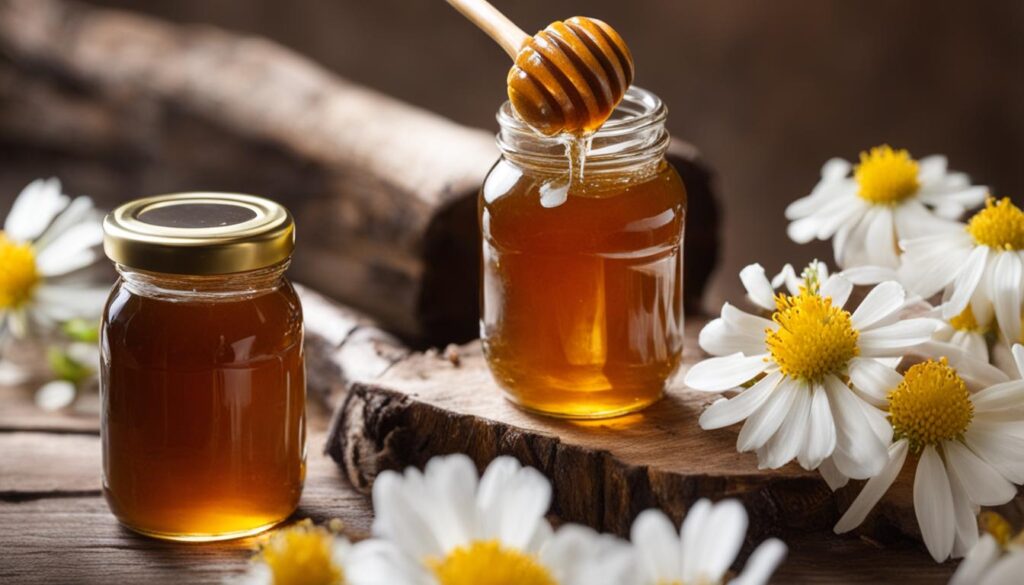
In addition to its current uses, honey has the potential for various additional applications. The antimicrobial and anti-inflammatory properties of honey make it a promising ingredient in the development of new healthcare products and wound dressings. Research continues to explore the potential benefits of honey for various conditions, including diabetes management, cancer treatment, gastrointestinal disorders, and oral health. Future studies may shed further light on the specific mechanisms and potential uses of honey in these areas.
Promising Areas of Future Research
Diabetes Management: Studies have shown that honey may have positive effects on blood sugar control and insulin sensitivity in individuals with diabetes. Further research is needed to determine the optimal dose, frequency, and type of honey for diabetes management, as well as its long-term effects on glycemic control.
Cancer Treatment: Preliminary lab studies and animal models have suggested that honey may have potential anticancer properties. It has been observed to inhibit the growth of cancer cells, induce apoptosis, and enhance the effectiveness of chemotherapy drugs. However, more research is required to understand the specific mechanisms and potential clinical applications of honey in cancer treatment.
Gastrointestinal Disorders: Honey has been traditionally used to relieve gastrointestinal conditions, such as acid reflux, gastritis, and stomach ulcers. Future research could further explore its effectiveness, mechanisms of action, and potential benefits in the management of these disorders.
Oral Health: Honey has demonstrated antimicrobial and anti-inflammatory properties that may be beneficial in oral health. It has shown promise as a natural remedy for oral infections, periodontal disease, and the prevention of tooth decay. Future studies could explore its role in maintaining oral hygiene and promoting overall oral health.
“The potential uses of honey in various healthcare applications are a subject of ongoing research. Its unique properties and compounds make it an intriguing ingredient in the development of innovative treatments and therapies.” – Dr. Jane Williams, Professor of Biochemistry
As research progresses, the potential uses of honey in healthcare and other areas are likely to expand. It is an exciting time for honey research, as scientists strive to unlock its full potential and discover novel applications for this natural and versatile substance.
Note: The image is for illustrative purposes only and does not represent a specific research study on honey.
The Versatility of Honey
Honey is a remarkable ingredient that offers a multitude of uses and benefits, making it a truly versatile elixir. Its natural sweetness and flavor-enhancing properties make it a perfect choice for culinary applications, adding a delightful touch to both sweet and savory dishes. As a natural sweetener, honey can enhance the taste of desserts, teas, and beverages, providing a healthier alternative to refined sugar.
Not only is honey a culinary delight, but it also holds significant value in the realms of skincare, haircare, and natural remedies. Its antioxidant properties help combat the damaging effects of free radicals, contributing to healthier skin and a youthful appearance. Honey’s antibacterial and anti-inflammatory qualities make it an effective ingredient in facial masks and moisturizers, promoting a clear and radiant complexion.
When it comes to haircare, honey’s moisturizing and healing properties can nourish and strengthen the hair, leaving it soft, silky, and revitalized. In addition, honey boasts a rich history of usage in natural remedies. It has been used for centuries to soothe coughs, relieve allergies, aid in weight loss, and promote wound healing. Its versatility as a holistic remedy cannot be overstated.
Whether used internally or externally, honey plays a vital role in enhancing both personal and household experiences. Its diverse range of applications and its numerous health benefits make it a prized addition to any lifestyle. Embrace the versatility of honey and unlock its myriad uses and benefits for a sweeter, healthier, and more fulfilling life.
FAQ
What is honey?
Honey is a sweet fluid made by honeybees using the nectar of flowering plants.
What are the benefits of honey?
Honey has various benefits, including acting as a natural sweetener, reducing the risk of cardiovascular disease, suppressing coughs, relieving gastrointestinal conditions, offering neurological benefits, and promoting wound healing.
How long has honey been used?
Honey has been used by humans for thousands of years and is mentioned in ancient texts, such as the Quran and Egyptian records.
What are the key components of honey?
Honey contains mostly sugar, as well as amino acids, vitamins, minerals, iron, zinc, and antioxidants. It is also rich in health-promoting plant compounds called polyphenols.
How can honey be used in cooking?
Honey serves as a natural sweetener and can be used to enhance the flavor of both sweet and savory dishes. It can be drizzled over yogurt, added to smoothies, used as a glaze for meats, incorporated into salad dressings, and used in baked goods.
How is honey beneficial for personal care?
Honey contains antibacterial and anti-inflammatory properties, making it beneficial for skincare. It can be used as a facial mask, moisturizer, or ingredient in homemade skincare products. Honey is also known for its moisturizing and healing effects on the hair and scalp.
What are some household and topical uses of honey?
Honey can be used as a natural cough suppressant, aid in weight loss, and promote wound healing. It can be applied topically to minor sores and wounds to promote healing and alleviate pain.
What are the specific benefits and applications of honey?
Honey has antioxidant properties that may reduce the risk of heart disease and improve blood fat levels. It may also have antidepressant, anticonvulsant, and anti-anxiety benefits. Additionally, honey shows effectiveness in promoting wound healing, particularly in burns.
Are there any cautions when using honey?
Honey should be avoided in infants due to the risk of infant botulism. Some individuals may be sensitive or allergic to specific components in honey. It can also affect blood sugar levels, so moderation is advised, especially for individuals with diabetes. Honey adulteration should also be considered.
How can I select the best quality honey?
Look for honey that is labeled as pure or raw. Consider purchasing honey from reputable sources or local beekeepers. Check the color, consistency, and aroma of the honey, and choose independently tested or certified varieties.
How should honey be stored?
Honey should be stored in a cool, dry place, away from direct sunlight and excessive heat. It does not require refrigeration but should be kept in a tightly sealed container to prevent moisture absorption and crystallization.
What additional uses and research are there on honey?
Honey has the potential for various additional applications, such as in healthcare products and wound dressings. Research continues to explore the benefits of honey for diabetes management, cancer treatment, gastrointestinal disorders, and oral health.
How versatile is honey?
Honey serves as a natural sweetener, flavor enhancer, and has various health benefits. It can be used in cooking, personal care products, health remedies, household applications, and has the potential for even more uses.






